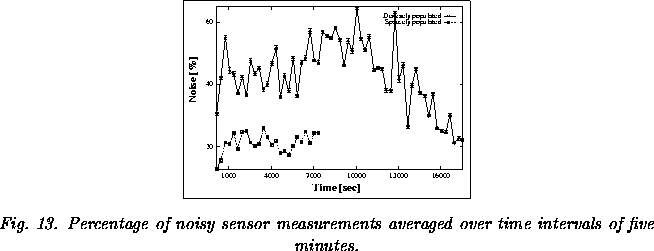


Next: Tracking the Robot's Position
Up: Long-term Experiments in Dynamic
Previous: Long-term Experiments in Dynamic

During the experiments, we used two different datasets. These sets
differ mainly in the amount of sensor noise.
- The first dataset was collected during 2.0 hours of robot
motion, in which the robot traveled approximately 1,000 meters. This
dataset was collected when the museum was closed, and the robot guided
only remote Internet-visitors through the museum. The robot's top
speed was 50cm/sec. Thus, this dataset was ``ideal'' in that the
environment was only sparsely populated, and the robot moved slowly.
- The second dataset was recorded during a period of 4.8 hours,
during which Rhino traveled approximately 1,540 meters. The path of
this dataset is shown in Figure 12(a). When
collecting this data, the robot operated during peak traffic hours. It
was frequently faced with situations such as the one illustrated in
Figure 7. The robot's top speed was 80cm/sec.
Both datasets consist of logs of odometry and laser range-finder
scans, collected while the robot moved through the museum. Using the
time stamps in the logs, all tests have been conducted in real-time
simulation on a SUN-Ultra-Sparc 1 (177-MHz). The first dataset
contained more than 32,000, and the second dataset more than 73,000
laser scans. To evaluate the different localization methods, we
generated two reference paths, by averaging over the estimates
of nine independent runs for each filter on the datasets (with small
random noise added to the input data). We verified the correctness of
both reference paths by visual inspection; hence, they can be taken as
``ground truth.''

Figure 13 shows the estimated percentage of corrupted
sensor readings over time for both datasets. The dashed line
corresponds to the first data set, while the solid line illustrates
the corruption of the second (longer) data set. In the second
dataset, more than half of all measurements were corrupted for
extended durations of time, as estimated by analyzing each laser
reading post-facto as to whether it was significantly shorter than the distance
to the next obstacle.



Next: Tracking the Robot's Position
Up: Long-term Experiments in Dynamic
Previous: Long-term Experiments in Dynamic
Dieter Fox
Fri Nov 19 14:29:33 MET 1999
